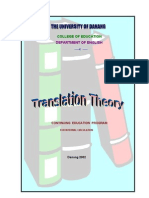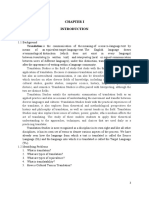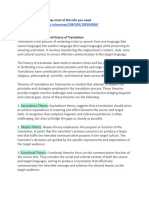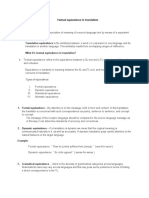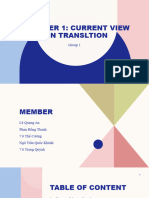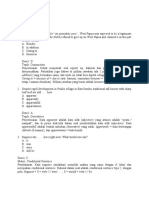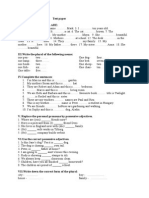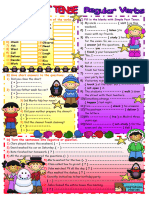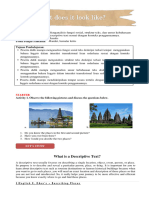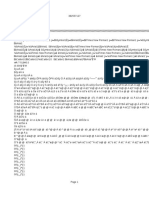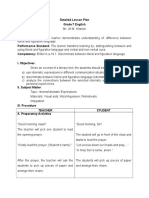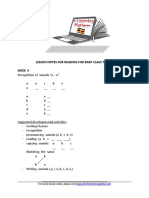Conspect - T
Uploaded by
Valeria BîtaConspect - T
Uploaded by
Valeria Bîta1.
The General Theory of Translation refers to the principles and
concepts that guide the translation process from one language to 5.Realia translation involves the translation of cultural and social
another. It emphasizes that translation is not just a matter of references that may not have an equivalent in the target language.
transferring words but involves decoding the original text's meaning Translators must carefully consider the cultural and linguistic
and re-encoding it in the target language. The theory also highlights context of both languages to accurately convey the meaning of
the importance of a translator's understanding of both the source and realia in the target language
target languages and cultures to produce an accurate and effective
translation.
6.The translation of false friends refers to words in different
The Denotative Theory of Translation emphasizes the accurate languages that look or sound similar but have different meanings.
translation of the denotative or literal meaning of a text. It assumes Translators must be aware of these false friends and ensure that they
that meaning is objective and can be transferred from one language to accurately translate the intended meaning of the source text.
another without adding any interpretation or subjective elements.
However, it may not fully account for the cultural and social nuances Phraseologisms are expressions that have a fixed meaning in a
that can influence meaning and interpretation. particular language or culture. These expressions may not have an
equivalent in the target language, and translators must carefully
The Transformational Theory of Translation emphasizes the consider the context and meaning of the phraseologism in order to
importance of translating not just the words but also the underlying accurately convey its intended meaning.
meaning and intent of a text. It recognizes that language and culture
are closely intertwined and the translator must be aware of the Translating false friends and phraseologisms requires a deep
nuances and connotations of the original text. The theory highlights understanding of both the source and target languages and cultures.
the need for a deep understanding of both the source and target Translators must be aware of the potential pitfalls of false friends and
languages and cultures to produce an accurate and effective phraseologisms and strive to accurately convey the intended meaning
translation. of the source text while also ensuring that the translated text is
accessible and meaningful to the target audience.
The Semantic Theory of Translation emphasizes the importance of
meaning in the translation process, and the goal of translation is to 7.Translation techniques are the methods and strategies used by
convey the meaning of the source text in the target language. translators to accurately convey the meaning of the source text in the
Equivalence is also a key concept in this theory, and the translator target language. These techniques include literal translation,
must find the most appropriate form of equivalence for each context paraphrasing, adaptation, cultural equivalent translation, and
to accurately convey the meaning of the source text. Eugene Nida, a transcreation, and the choice of technique depends on various factors,
prominent scholar in translation studies, introduced the concept of including the type of text and the intended audience. Translators must
dynamic equivalence, which involves going beyond the literal meaning carefully consider these factors in order to choose the most appropriate
of words and considering the cultural and linguistic context of the text. technique and produce a successful translation.
2. Equivalence is a fundamental concept in translation studies that refers 8.The grammar aspect in translation is essential for producing an
to the relationship between the source text and the target text. It involves accurate and coherent translation. Translators must have a deep
finding the most appropriate way to convey the meaning of the source text understanding of the grammar rules and structures of both the source
in the target language, while taking into account the cultural and linguistic and target languages in order to produce a high-quality translation. Any
differences between the two languages. Equivalence can be achieved at errors or inconsistencies in grammar can result in a mistranslation and
different levels, including lexical, grammatical, and cultural equivalence, negatively impact the overall quality of the translated text.
and the translator must choose the most appropriate form of equivalence
for each context in order to accurately convey the meaning of the source 9.Attributive groups refer to noun phrases in which an adjective
text. modifies a noun. Translating attributive groups involves accurately
conveying the relationship between the noun and adjective in the target
In translation studies, there are several types of equivalents that language.
translators may use to achieve equivalence between the source text
and the target text. These include literal equivalence, functional In some cases, the adjective-noun relationship may be reversed in the
equivalence, dynamic equivalence, and cultural equivalence. While target language, requiring the translator to rearrange the attributive
literal equivalence preserves the original meaning of the text, it may group in order to accurately convey the intended meaning.
not always be appropriate due to differences in grammar and
idiomatic expressions. On the other hand, dynamic equivalence takes Sociolinguistics is the study of the relationship between language
into account the cultural and linguistic context of both languages, and society, and it plays an important role in translation.
while cultural equivalence is particularly important when translating Translators must be aware of the social and cultural context of
literature with cultural references. The choice of which type of both the source and target languages in order to accurately convey
equivalent to use depends on the specific context of the translation and the intended meaning of the source text. An understanding of
the translator's goals. sociolinguistics is essential for producing a successful translation
that is appropriate for the intended audience and cultural context.
3.The unit of translation refers to the smallest linguistic unit that can
be translated as a single entity. The choice of the unit of translation
depends on several factors, such as the language pair, type of text, and
intended purpose of the translation. The unit of translation can be a
single word, phrase, sentence, or even a paragraph, and some
translation theorists argue for a semantic approach that focuses on
translating the underlying concepts rather than individual words or
phrases.
4.The lexical aspects of translation involve the translation of individual
words and their meanings from the source language to the target
language. Translators must carefully consider the context and
intended meaning of each word in the source text, which may involve
choosing a different word with a similar meaning or adjusting the
sentence structure. Collocation, or the way words are commonly used
together in a language, is also an important consideration in lexical
translation.
Context plays a crucial role in translation, as it can significantly
impact the meaning and accuracy of the translation. There are several
translation situations that may affect the context, including literary,
technical, and legal translation.
When translating context-free words, such as technical terms or
proper nouns, the focus is on accurately conveying the meaning of the
word in the target language. However, when translating context-
bound words, such as idioms or cultural references, the translator
must consider the cultural and linguistic context of both languages in
order to accurately convey the intended meaning.
You might also like
- Giao Trinh Theory of Translation and Interpretation 1100% (3)Giao Trinh Theory of Translation and Interpretation 1181 pages
- Translation As Means of Communication in Multicultural WorldNo ratings yetTranslation As Means of Communication in Multicultural World4 pages
- Issues in Translation & Formal and Dynamic EquivalenceNo ratings yetIssues in Translation & Formal and Dynamic Equivalence5 pages
- 2213321009-Katrin Oktavia K Sihombing-UTS Translation in ELTNo ratings yet2213321009-Katrin Oktavia K Sihombing-UTS Translation in ELT3 pages
- Translation Is The Communication of The Meaning of A Source-Language Text byNo ratings yetTranslation Is The Communication of The Meaning of A Source-Language Text by6 pages
- Tài liệu tham khảo DỊCH ĐẠI CƯƠNG Bài 1 +2No ratings yetTài liệu tham khảo DỊCH ĐẠI CƯƠNG Bài 1 +29 pages
- Translation, Translation Strategy, Translation Procedure, Translation Method, Translation Technique, Translation TransformationNo ratings yetTranslation, Translation Strategy, Translation Procedure, Translation Method, Translation Technique, Translation Transformation15 pages
- Methods and Principles of Translation-Chapter 1No ratings yetMethods and Principles of Translation-Chapter 140 pages
- Economic Translation Theoretical and Practical IssuesNo ratings yetEconomic Translation Theoretical and Practical Issues7 pages
- A Stylistic Analysis of Modality in Three Translations of Dmect Communicative Discourse in The Holy Qur'AnNo ratings yetA Stylistic Analysis of Modality in Three Translations of Dmect Communicative Discourse in The Holy Qur'An176 pages
- CIT-01-Unit-01-Meaning, Nature and Scope of Translation PDFNo ratings yetCIT-01-Unit-01-Meaning, Nature and Scope of Translation PDF20 pages
- Historical Background of Translation Equivalence TheoryNo ratings yetHistorical Background of Translation Equivalence Theory3 pages
- The Linguistics Of History Roy Harris downloadNo ratings yetThe Linguistics Of History Roy Harris download91 pages
- Summary Topic 4 - Psycholinguistics and Foreign Language TeachingNo ratings yetSummary Topic 4 - Psycholinguistics and Foreign Language Teaching9 pages
- Ed Pronunciation + Past Simple ExercisesNo ratings yetEd Pronunciation + Past Simple Exercises5 pages
- K To 12 Curriculum Guide in English (Grades 7-10) : Grade 7 Grade 8 Grade 9 Grade 10100% (1)K To 12 Curriculum Guide in English (Grades 7-10) : Grade 7 Grade 8 Grade 9 Grade 102 pages
- IFL Preparation Course Afternoon Class - Day 4No ratings yetIFL Preparation Course Afternoon Class - Day 417 pages
- Anglaisexamen Admission s22021 Seulement Pour L EcNo ratings yetAnglaisexamen Admission s22021 Seulement Pour L Ec11 pages
- Table of Specifications in English 8: Third Quarterly AssessmentNo ratings yetTable of Specifications in English 8: Third Quarterly Assessment1 page
- Assessing Culturally and Linguistically Diverse Students A Practical Guide Full-Feature Download100% (9)Assessing Culturally and Linguistically Diverse Students A Practical Guide Full-Feature Download17 pages












